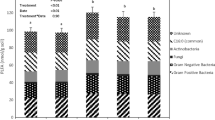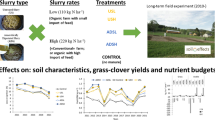Abstract
Field trials were carried out between 2002 and 2005 to investigate the effects of biogas digestion in a mixed organic dairy farming system with arable land and grassland on nutrient cycling, nitrogen (N) uptake and crop yields within a cropping system comprising a whole crop rotation. Five treatments were carried out: (i) solid farmyard manure, (ii) undigested liquid slurry, (iii) digested liquid slurry, (iv) digestion of liquid slurry and field residues such as crop residues and cover crops, and (v) similar to iv, but with additional N inputs at the equivalent of 40 kg N ha−1 farmland through digestion of purchased substrates. The term “manure” is used in the present study to mean all kind of aboveground organic residues left on the field (“immobile manures”, such as crop residues and green manures incorporated directly into the soil) or added as stable wastes or effluents of biogas digestion (“mobile manures”). The total aboveground biomass growth and the overall aboveground N uptake of non-legume maincrops were higher in the liquid slurry manure treatment than in the solid farmyard manure system (+5% and +9%, respectively). The digestion of the liquid slurry increased N uptake and crop yields only after soil incorporation of the slurry shortly after field spreading. The additional collection and digestion of field residues such as cover crops and crop residues, combined with a reallocation of the effluents, strongly increased the amounts of “mobile” manure, allowing a more focussed allocation of the available N. This led to an increase in the aboveground N uptake (+12%) and biomass yield (+4%) of the five non-legume crops, due to a better adapted allocation of nutrients in space and time. Results obtained with spring wheat showed that removal of cover crops in autumn, and their digestion, combined with subsequent use as manure in spring resulted in a better synchronisation of the crop N demand and the soil N availability, in comparison with a strategy where the biomass was left on the field as green (immobile) manure. The inclusion of external substrates led to a further increase of 8% in N uptake, but not to a significant increase in aboveground dry matter yields.

Similar content being viewed by others
Abbreviations
- CC:
-
Cover crop
- CrRo:
-
Crop rotation
- CR:
-
Crop residues such as straw
- DM:
-
Dry matter
- FM:
-
Fresh matter, fresh weight
- MV:
-
Mean value
- N:
-
Nitrogen
- NUE:
-
N use efficiency
- P:
-
Phosphorus
- SMN:
-
Soil mineral N
- FYM:
-
Soil farmyard manure
- US:
-
Liquid undigested slurry
- DS:
-
Liquid digested slurry
- DS + FR:
-
Digestion of slurry and field residues
- DS + FER:
-
Digestion of slurry, field residues and external substrates
References
Asmus F, Linke B, Dunkel H (1988) Eigenschaften und Düngerwirkung von ausgefaulter Gülle aus der Biogasgewinnung. Arch Acker- Pflanzenbau Bodenkd Berlin 32:527–532
Azevedo J, Stout PR (1974) Farm animal manures: an overview of their role in the agricultural environment. Calif Agric Exp Stn & Ext Ser Manual 44
Barrow NJ (1961) Mineralization of nitrogen and sulphur from sheep faeces. Aust J Agric Res 12:644–650. doi:10.1071/AR9610644
Berensten PBM, Giesen GWJ, Schneiders MMFH (1998) Conversion from conventional to biological dairy farming: economic and environmental consequences at farm level. Biol Agric Hortic 16:311–328
Bernal PM, Kirchmann H (1992) Carbon and nitrogen mineralization and ammonia volatilization from fresh, aerobically and anaerobically treated pig manure during incubation with soil. Biol Fertil Soils 13:135–141
Berry PM, Sylvester-Bradley R, Phillips L, Hatch DJ, Cuttle SP, Rayns FW et al (2002) Is the productivity of organic farms restricted by the supply of available nitrogen? Soil Use Manag 18:248–255. doi:10.1079/SUM2002129
Besson J-M, Lehmann V, Roulet M, Lischer P (1982) Inhaltstoffe der belüfteten Gülle sowie Einfluss der Methangärung auf die Güllezusammensetzung in Praxisbetrieben. Mitt Schweiz Landw 30:149–161
Besson J-M, Schmitt R, Lehmann V, Soder M (1987) Unterschiede im Keimverhalten von Unkrautsamen nach Behandlung mit gelagerter, belüfteter und methanvergorener Gülle. Mitt Schweiz Landw 35:73–80
Dahlin S, Kirchmann H, Kätterer T, Gunnarsson S, Bergström L (2005) Possibilities for improving nitrogen use from organic materials in agricultural cropping systems. Ambio 34:288–295. doi:10.1639/0044-7447(2005)034[0288:PFINUO]2.0.CO;2
Dewes T, Ahrens E, Willing O (1991) Sickersaft-Austrag und Stickstoff-Fracht aus Mistmieten. J Agron Crop Sci 166:145–151. doi:10.1111/j.1439-037X.1991.tb00897.x
Dosch P, Gutser R (1996) Reducing N losses (NH3, N2O, N2) and immobilization from slurry through optimized application techniques. Fertil Res 43:165–171. doi:10.1007/BF00747697
Edelmann W, Engeli H, Gradenecker M, Ilg M, Joss A, Müller J, Rottermann K, Ulrich P (1996) Zweistufige Vergärung von festen biogenen Abfallstoffen. Abschlussbericht. Arbeitsgemeinschaft Bioenergie, Maschwanden, Switzerland
Elsässer M, Kunz HG, Briemle G (1995) Unterschiedliche technische Behandlung von Gülle und deren Auswirkung auf intensiv genutztes Dauergrünland. J Agron Crop Sci 174:253–264. doi:10.1111/j.1439-037X.1995.tb01111.x
Field JA, Caldwell JS, Jeyanayagam S, Reneau RB, Kroontje W, Collins ER (1984) Fertilizer recovery from anaerobic digesters. Trans Am Soc Agric Eng 27:1871–1876
Fleischer E (1998) Nutztierhaltung und Nährstoffbilanzen in der Landwirtschaft. Analytica Verlagsgesellschaft, Berlin
Freytag HE, Rausch H (1982) Prinzipieller Verlauf der C-N-Transformationsprozesse im Boden bei Anwesenheit verschiedener organischer Dünger. Arch Acker- Pflanzenbau Bodenkde 26:407–415
Gutser R, Amberger A, Vilsmeier K (1987) Wirkung unterschiedlich aufbereiteter Gülle im Gefäßversuch zu Hafer und Weidelgras. VDLUFA-Schriftenreihe 23:279–296
Gutser R, Nitschke A, Klasnik A (1997) Umweltschonende Verwertung von Reststoffen verschiedener Gülleaufbereitungsverfahren. In: KTBL-Arbeitspapier 242: Umweltverträgliche Gülleaufbereitung und Verwertung, S. 97–108
Gutser R, Ebertseder T, Weber A, Schraml M, Schmidhalter U (2005) Short-term and residual availability of nitrogen after long-term application of organic fertilizers on arable land. J Plant Nutr Soil Sci 168:439–446. doi:10.1002/jpln.200520510
He DY, Liao XL, Xing TX, Zhou WJ, Fang YJ, He LH (1994) The fate of nitrogen from 15N-labeled straw and green manure in soil-crop-domestic animal systems. Soil Sci 158:65–73. doi:10.1097/00010694-199407000-00008
Hege U, Offenberger K (2006) Effect of differentiated mineral fertilization and organic manuring on yield, product quality and N balances in the international permanent organic nitrogen experiment (IOSDV) Puch. Arch Agron Soil Sci 52:535–550. doi:10.1080/03650340600931650
Hoffmann G (1991) VDLUFA-Methodenbuch Band I: Die Untersuchung von Böden, VDLUFA-Verlag
Kirchmann H, Lundvall A (1993) Relationship between N immobilization and volatile fatty acids in soil after application of pig and cattle slurry. Biol Fertil Soils 15:161–164. doi:10.1007/BF00361605
Kirchmann H, Witter E (1992) Composition of fresh, aerobic and anaerobic farm animal dungs. Bioresour Technol 40:137–142. doi:10.1016/0960-8524(92)90199-8
Koriath H, Herrmann V, Vollmer GR, Franz J (1985) Nährstoffdynamik während der anaeroben Fermentation von Gülle und Wirkung auf den Ertrag und Inhaltsstoffe von Mais im Gefäßversuch. Arch Acker- u Pflanzenbau u Bodenkd 29:741–747
Lambert R, Toussaint B, Peeters A (2004) Estimating nitrogen losses from animal manures using their phosphorus balance. In: Hatch DJ, Chadwick DR, Jarvis SC, Roker JA (eds) Controlling nitrogen flows and losses. Wageningen Academic, Wageningen, pp 518–519
Loria ER, Sawyer JE (2005) Extractable soil phosphorus and inorganic nitrogen following application of raw and anaerobically digested swine manure. Agron J 97:879–885. doi:10.2134/agronj2004.0249
Martin JH (2004) A comparison of dairy cattle manure management with and without anaerobic digestion and biogas utilization. Report for the AgSTAR Program, U.S. Environmental Protection Agency, Contract No. 68-W7-0068, Task Order No. 400, pp. 58. http://www.ncgreenpower.org/documents/nydairy2003.pdf. Accessed 2 Feb 2007
Masse L, Massé DI, Beaudette V, Muir M (2004) Particle size distribution and characteristics of raw and anaerobically digested swine manure slurry. ASAE/CSAE Meeting Presentation, Paper Number 044085
Merz HU (1988) Untersuchungen zur Wirkung von unbehandelter und methanvergorener Rindergülle auf den N-Umsatz unter Dactylis glomerata L. sowie auf das Keimverhalten verschiedener Pflanzenarten. Diss., Univ. Hohenheim
Messner H (1988) Düngewirkung anaerob fermentierter und unbehandelter Gülle. Diss., TU München
Möller K, Stinner W (2008a) Effects of different manuring systems with and without biogas digestion on soil mineral nitrogen content and on gaseous nitrogen losses (ammonia, nitrous oxides). Eur J Agron. doi:10.1016/j.eja.2008.06.003 (in press)
Möller K, Stinner W (2008b) Mineral nutrient flows between arable land and grassland via the stable, and effects of biogas digestion on mineral nutrient availability, flows and balances in organic cropping systems. Nutr Cycl Agroecosyst (submitted)
Möller K, Habermeyer J, Zinkernagel V, Reents HJ (2006) The impact and the interaction of nitrogen and Phytophthora infestans as yield-limiting and yield-reducing factors in organic potato (Solanum tuberosum L.) crops. Potato Res 49:281–301. doi:10.1007/s11540-007-9024-7
Möller K, Stinner W, Leithold G (2008) Growth, composition, biological N2 fixation and nutrient uptake of a leguminous cover crop mixture and the effect of their removal on field nitrogen balances and nitrate leaching risk. Nutr Cycl Agroecosyst (in press). doi:10.1007/s10705-008-9182-2
Pang XP, Letey J (2000) Organic farming: challenge of timing nitrogen availability to crop nitrogen requirements. Soil Sci Soc Am J 64:247–253
Petersen J (2005) Competition between weeds and spring wheat for 15N-labelled nitrogen applied in pig slurry. Weed Res 45:103–113. doi:10.1111/j.1365-3180.2004.00429.x
Petersen SO, Lind A-M, Sommer SG (1998) Nitrogen and organic matter losses during storage of cattle and pig manure. J Agric Sci Camb 130:69–79. doi:10.1017/S002185969700508X
Rasmussen K (2002) Influence of liquid manure application method on weed control in spring cereals. Weed Res 42:287–298. doi:10.1046/j.1365-3180.2002.00286.x
Rauhe K (1987) Effects of organic manuring and cropping on soil humus and fertility. In: Welte E, Szabolccs I (eds) Proceedings of the 4th international CIEC symposium ‘agricultural waste management and environmental protection’, Braunschweig, Germany, 11–14 May 1987, pp 55–76
Reinhold G, Klimanek E-M, Breitschuh G (1991) Zum Einfluss der Biogaserzeugung auf Veränderungen in der Kohlenstoffdynamik von Gülle. Arch Acker- Pflanzenbau Bodenkd 35:129–137
Schrade S, Pekrun C, Oechsner H, Claupein W (2003) Untersuchungen zum Einfluss der Biogasgärung auf die Keimfähigkeit von Unkraut- und Kulturpflanzensamen unter besonderer Berücksichtigung des Ampfers (Rumex obtusifolius). In: Freyer B (ed) Proceedings of 7. Wissenschaftstagung zum Ökologischen Landbau, Wien, Austria, 24–26 Mar 2003, pp 531–532. http://orgprints.org/8989/. Accessed 7 Aug 2007
Schröder J (2005) Revisiting the agronomic benefits of manure: a correct assessment and exploitation of its fertilizer value spares the environment. Bioresour Technol 96:253–261. doi:10.1016/j.biortech.2004.05.015
Schüller H (1969) Die CAL-Methode, eine neue Methode zur Bestimmung des pflanzenverfügbaren Phosphates in Böden. Z Pflanzenernähr u Bodenkd 123:48–63. doi:10.1002/jpln.19691230106
Schulz H, Eder B (2001) Biogas Praxis—Grundlagen, Planung, Anlagenbau, Beispiele. Ökobuch-Verlag, 2. Auflage, Staufen bei Freiburg
Sommer SG, Jensen LS, Clausen SB, Søgaard HT (2006) Ammonia volatilization from surface-applied livestock slurry as affected by slurry composition and slurry infiltration depth. J Agric Sci Camb 144:229–235
Sommers LE, Sutton AL (1980) Use of waste materials as sources of phosphorus. In: Khasawneh FE, Sample EC, Kamprath EJ (eds) The role of phosphorus in agriculture. ASA–CSSA–SSSA, Madison, pp 515–544
Sørensen P, Amato M (2002) Remineralisation and residual effects of N after application of pig slurry to soil. Eur J Agron 16:81–95. doi:10.1016/S1161-0301(01)00119-8
Sørensen P, Jensen ES (1998) The use of 15N labelling to study the turnover and utilization of ruminant manure N. Biol Fertil Soils 28:56–63. doi:10.1007/s003740050463
Steffens D, Mühling KH, Schubert S (2004) Agrikulturchemisches Praktikum. Verlag Grauer, Beuren, Stuttgart
Steinshamn H, Thuen E, Azzaroli Bleken M, Brenøe UKT, Ekerholt G, Yri C (2004) Utilization of nitrogen (N) and phosphorus (P) in an organic dairy farming system in Norway. Agric Ecosyst Environ 104:509–522. doi:10.1016/j.agee.2004.01.022
Svensson K, Odlare M, Pell M (2004) The fertilizing effect of compost and biogas residues from source separated household waste. J Agric Sci Camb 142:461–467
Torstensson G (1998) Nitrogen delivery and utilization by subseqent crops after incorporation of leys with different plant composition. Biol Agric Hortic 16:129–143
Thorup-Kristensen K, Magid J, Jensen LS (2003) Catch crops and green manures as biological tools in nitrogen management in temperate zones. Adv Agron 79:227–302. doi:10.1016/S0065-2113(02)79005-6
Walter H (1957) Wie kann man den Klimatypus anschaulich darstellen? Umschau 57:751–754
Acknowledgement
The authors wish to thank Elke Christ, Stefanie Schmiegel, Heinrich Heberlein, Theo DeZeeuw, Harald Schmidt, Diedrich Steffens, Franz Schulz and Doris Franz for many useful discussions and provided technical assistance. This research was supported by the “Deutsche Bundesstiftung Umwelt”.
Author information
Authors and Affiliations
Corresponding author
Rights and permissions
About this article
Cite this article
Möller, K., Stinner, W., Deuker, A. et al. Effects of different manuring systems with and without biogas digestion on nitrogen cycle and crop yield in mixed organic dairy farming systems. Nutr Cycl Agroecosyst 82, 209–232 (2008). https://doi.org/10.1007/s10705-008-9196-9
Received:
Accepted:
Published:
Issue Date:
DOI: https://doi.org/10.1007/s10705-008-9196-9




